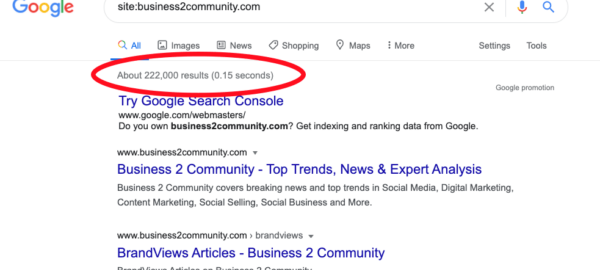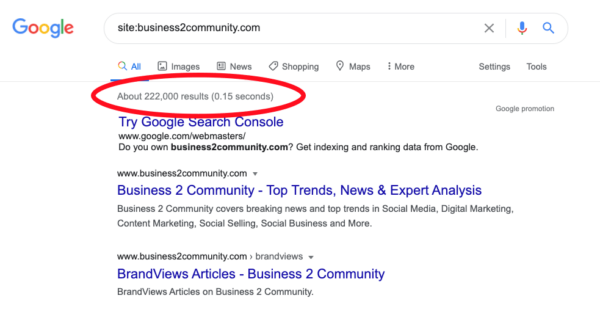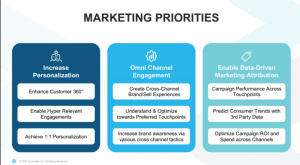One of the great aspects of digital marketing is that everything can be tracked. However, that wealth of data can also be our downfall if we don’t know how to sift through all the noise and focus on the right metrics. There are a thousand different metrics you can measure related to search engine optimization. It’s so much that you can quickly become overwhelmed by all the different numbers.
Here’s a better idea: Forget about 95% of all the SEO metrics you could focus on and just make sure you’re improving in these five key metrics and you’ll see your SEO results skyrocket.

- Pixabay
1. Organic Search Traffic
You could optimize every page on your website with a new SEO strategy, but if it doesn’t bring you any traffic, then what’s the point? Organic search traffic is one of the best indicators of whether your SEO is performing well or not. For example, a month-over-month lift in visitors through organic search shows that your site is ranking higher and showing up for more keywords that people are searching for.
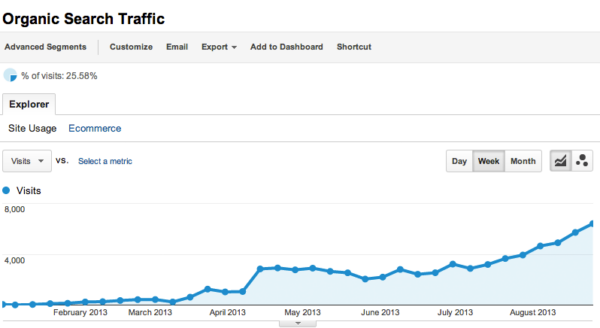
- Google Analytics
You can easily track organic search traffic in Google Analytics. To get a quick snapshot of your organic search traffic, look at “Channels” underneath “Acquisition” within Google Analytics to see all total sessions in comparison to other channels. Change the time period of the report to see how organic search traffic compared to past weeks or months. This is helpful to know where organic traffic is coming from so you can continue to build content and expand upon your strategy.
You can also dig deeper into the behavior of website visitors coming from organic search by adding an organic search segment in Analytics. When you log in, click on “Add Segment” at the top of any report and select “Organic Traffic” to see only data from organic search visitors for the selected report.
2. Branded vs Non-Branded Keyword Traffic
Branded keywords refer to queries that include your brand or product name, as well as any variations. For example, Nike shoes, Nike running shoes, Nike basketball shoes, or Nike non-slip shoes are all branded keywords for Nike.
Keywords that don’t reference your brand or company name are known as non-branded keywords. If your content is ranking well, then you’ll have traffic for both branded and non-branded keywords.
It can be tricky to track branded and non-branded keywords for organic search in Google Analytics because Google doesn’t provide much organic keyword data. If you look at the keyword reports in Google Analytics, you’ll notice the majority of clicks fall under a keyword bucket simply identified as (not provided). That means that all of those clicks from organic search were encrypted by Google to protect their users’ privacy. There are still ways to capture some keyword data so you can track the breakdown of your search traffic by branded and non-branded keywords. The best source of keyword data is Google Search Console.
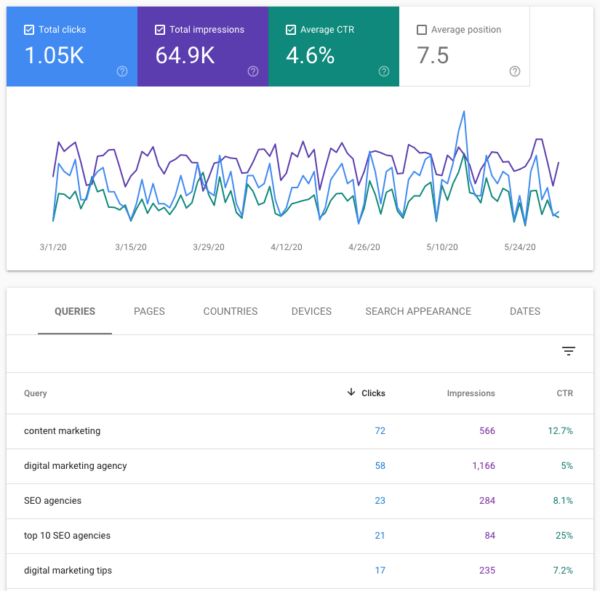
- Google Search Console
Within Google Search Console, look under “Performance” and then “Queries” to see the keyword queries that generate impressions and clicks for your site. You can select the time period and export the report to more easily sift through and separate branded and non-branded keywords. There are several third-party tools that integrate with Search Console to simplify the process and could save a bunch of time sifting through your data. These can be especially helpful if you have a large site with a lot of query data.
Google Analytics also has a report that pulls data from Search Console where you can see specific search keywords. You should also make sure that your Analytics and Google Search Console accounts are linked to access this data. Once your Analytics and Search Console accounts are connected, look under “Acquisition” and click “Queries.” While the report only shows the last 90 days of query information, you can see all keywords. With the advanced filter option, you can isolate branded and non-branded terms.
Once you’ve got a system in place to separate out branded and non-branded keyword traffic, track it on a monthly basis to see how it improves over time.
3. Conversions (Leads or Sales)
Traffic from organic search is the first step, but it doesn’t do you much good if that traffic isn’t converting into new customers. You should track your conversion rate from organic search traffic. What percentage of those organic search visitors take action and become a lead or complete a purchase? Conversion goals can be set up in Google Analytics for each call to action on your site. If you have a multiple-step checkout process, you can also look at Goal Flow reports to see how far organic search visitors get in the process.
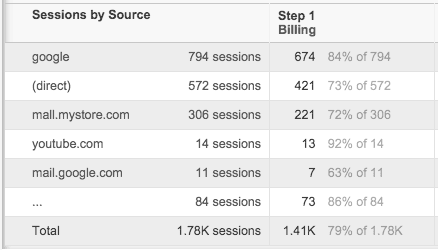
- Google Analytics
Conversion rates can be impacted by a number of different factors. One important factor for search traffic is where the searcher is in the buying cycle. If most of your traffic is coming from early research keywords, they may not yield immediate conversions, but that doesn’t mean it isn’t working. Be aware of how organic search works in conjunction with other traffic channels to drive overall conversions. Spend some time the “Multi-Channel Funnels” reports, including “Assisted Conversions” and the “Model Comparison Tool” to see how organic search can assist conversions that normally show up as coming from other channels. You may also find that organic search is over-attributed in some cases where navigational searches lead to a large number of leads or sales.
4. Time on Page from Organic Traffic
Another important metric to track is time on page from organic traffic. A couple of easy ways to track time on page are the “Average Time on Page” and “Average Session Duration” reports in Google Analytics. You can look at this number in aggregate for all organic search traffic or by individual pages.
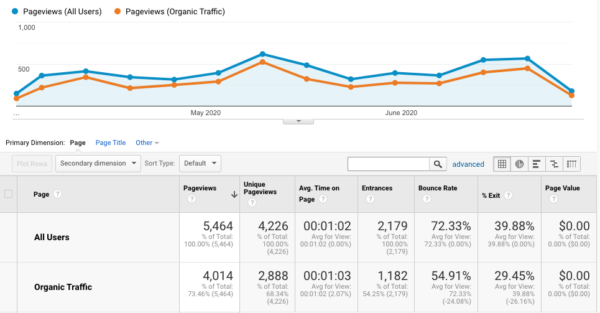
- Google Analytics
In general, a website visitor spending more time is better, but there are exceptions. For example, if you have a simple landing page that can be completed and submitted quickly, you can actually get great results from a very short time-on-page. Certain search queries, like a search for contact information, may be best served with a very short visit to the page. Use your best judgment to determine when a high bounce rate and short visit duration is a good thing or not.
If your visitors aren’t sticking around, take a hard look at your content and make sure you’re providing answers to what they are looking for. Add more content, useful links, and other resources to keep your site visitors engaged.
Duane Forrester, a Senior Project Manager at Bing, has said that websites should build content that keeps visitors on the page with content that answers all of their needs, encouraging more clicks and actions taken on the site before leaving.
If content doesn’t encourage your visitors to stay, they will leave. That’s also an important metric that search engines track. If you have low time-on-site metrics, it typically means visitors didn’t find what they were looking for. If you also have a high bounce rate from organic searches, that’s another indicator that your website isn’t relevant to the search query. This could negatively impact your search rankings for those keywords.
5. Pages Indexed in Google
One helpful metric to track is how many pages from your site are indexed in Google. Once you have established your SEO strategy, built your content, and published your pages, you expect that Google will start indexing them immediately. However, Google may not index your pages for many weeks in some cases. You can tell Google what pages to index within the Google Search Console tool and by creating an XML sitemap for your site. There are two main ways to see what pages are indexed.
Method #1: Use Google Search Site:-query
You can focus search results specifically around your website by searching “site:www.yourdomain.com” in Google Search. The results will be all the pages that Google is currently indexing. At the top, Google will tell you the total number of results, or the number of pages currently indexed.
So if you’ve built out 100 pages and only see 50 results, you know that some pages aren’t being indexed properly. You can use other site query tricks to see what pages in different directories are indexed as well as keywords.
Here are all the possible site queries:
- site:www.yourdomain.com/subdirectoryname (only pages within this subdirectory will display)
- site:www.yourdomain.com +specific keyword (displays on the indexed pages for this keyword)
- site:www.yourdomain.com inurl:keyword (just shows index pages which contain a certain keyword)
- site:www.yourdomain.com intitle:keyword (only returns keywords in the title or H1 of your page)
- site:www.yourdomain.com filetype:pdf (you can search by filetype on your domain including doc, pdf, ps, xls, rtf, and swf)
This method is the easiest to start measuring what’s indexed and what’s not. If you’re continually adding new content, you should see the number of pages indexed grow over time.
Method #2: Google Search Console
To analyze indexed pages within Google Search Console, log into your Google Search Console account, and select your website. Then click “Coverage” within the left sidebar, then click on “Indexed.” A graph displays where you can see the number of pages indexed, with a full list of indexed URLs below. Search Console is also helpful to identify any issues with pages that aren’t being indexed or that are blocked by robots.txt.
Other SEO metrics
While the above five metrics correlate to the most important metrics you should be tracking, there are many other SEO metrics that matter and can help you improve your SEO results. Here are a couple additional metrics that may be useful in addition to the big five:
New Backlinks and Referring Domains
One of the biggest factors in organic rankings is backlinks. All SEOs include linking strategies and try to earn as many backlinks as possible from high-ranking, high domain authority pages. In addition, if your page has similar content as competitors, the one with more backlinks will inevitably be ranked higher.
To track these metrics in Google Search Console, look under “Links > Top Linking Sites.” For further evaluation, use a tool like SEMrush or Agency Analytics to see a more comprehensive backlink report, including all domains referring to yours, as well as which links are no-follow.
Domain Authority Metrics
Moz coined the term “Domain Authority” and developed a score from 1 to 100 to determine the authority of a website. Domain Authority is essentially a measurement of the quality and quantity of links pointing to your site. A higher domain authority typically correlates with a site that is more highly trusted by the search engines.
Using the Moz link explorer tool, you can see your DA score as well as the DA scores of your competitors. It’s also trackable in many third-party tools.
Conclusion
Whether you’re just getting started, or you’ve been dominating Google for a decade, tracking the right metrics is critical to your SEO success. Avoid chasing vanity metrics that don’t yield real business results. It’s also important to note that your best measurement stick is your own site’s performance. Rather than chasing after a competitor or “industry averages,” if you focus on beating your previous records in these key metrics, you’ll find that you’re always moving in the right direction.
Digital & Social Articles on Business 2 Community
(47)
